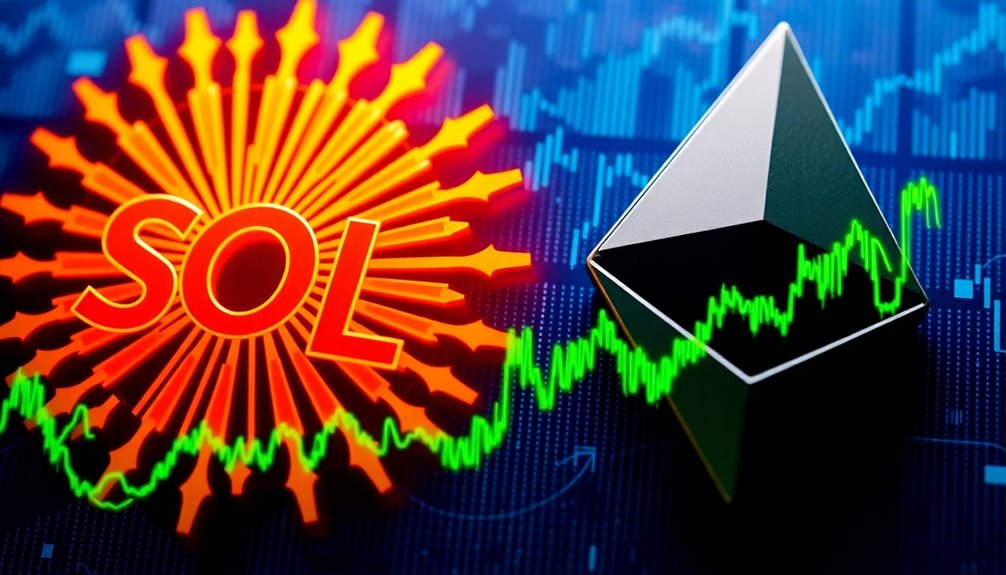SOL is the native cryptocurrency of the Solana blockchain, launched in March 2020. It's designed for high throughput and low costs, capable of processing up to 65,000 transactions per second with fees often under $0.01. You'll find it supports various decentralized applications, including DeFi and NFTs, making it a popular choice among developers. While it offers impressive speed and a thriving ecosystem, concerns about centralization and past network outages do exist. If you want to explore its features, advantages, and recent developments, there's a lot more to discover about SOL and its place in the crypto landscape.
Key Takeaways
- SOL is the native cryptocurrency of the Solana blockchain, launched in March 2020 by Solana Labs.
- It combines Proof of Stake (PoS) and Proof of History (PoH) for high speed and security.
- Solana can process 50,000 to 65,000 transactions per second with low fees averaging around $0.00025.
- The ecosystem supports decentralized applications (dApps), DeFi, NFTs, and gaming, attracting developers and users.
- Despite its advantages, Solana faces challenges including network congestion and concerns about centralization and outages.
Key Concepts of SOL Crypto

When diving into the key concepts of SOL crypto, you'll find that its innovative approach sets it apart in the blockchain landscape.
It combines Proof of Stake (PoS) and Proof of History (PoH) to enhance transaction security and speed. Validators stake SOL tokens to validate transactions, while PoH timestamps them for quick verification, eliminating unnecessary broadcasts across the network.
With a capacity of processing 50,000 to 65,000 transactions per second and block times around 400 milliseconds, you'll experience low fees and rapid confirmations. This impressive scalability allows Solana to compete with centralized payment processors like Visa.
The network employs Sealevel technology for parallel execution of smart contracts and integrates various applications like stablecoins and DeFi.
This efficient ecosystem positions SOL as a formidable player in the crypto space.
Overview of SOL Crypto

SOL crypto, developed by Solana Labs and launched in March 2020, represents a significant advancement in blockchain technology.
Founded by Anatoly Yakovenko and Greg Fitzgerald in 2017, this open-source project is managed by the Solana Foundation based in Geneva.
It employs a unique combination of Proof-of-History (PoH) and Delegated Proof-of-Stake (DPoS) to enhance security and transaction validation. High transaction speeds are a key feature that distinguishes Solana from other blockchain platforms.
PoH timestamps each transaction, while DPoS allows validators to stake SOL for network participation.
The network architecture includes components like Gulf Stream for transaction exchange and Sealevel as the processing engine.
SOL serves multiple purposes, from being used as collateral in decentralized finance (DeFi) applications to enabling interoperability with other blockchains, all at minimal transaction costs.
Transaction Speed and Efficiency

With an average transaction confirmation time of just 0.4 to 0.5 seconds, Solana stands out for its exceptional speed and efficiency. You can experience up to 65,000 transactions per second, thanks to its innovative Proof-of-Stake (PoS) and Proof-of-History (PoH) mechanisms. This high throughput not only reduces network congestion but also keeps transaction fees low. Additionally, validators check transaction authenticity and account balance rapidly, enhancing the overall performance of the network. Fast transaction speeds enhance real-time applications, like cross-border payments and micro-transactions, making it ideal for today's fast-paced digital economy. Additionally, larger block sizes and well-performing validators further enhance performance, ensuring that you enjoy a seamless experience.
Pros and Cons

While evaluating any cryptocurrency, it's essential to weigh the pros and cons, and Solana (SOL) is no exception.
On the positive side, SOL boasts high scalability, processing up to 50,000 transactions per second with minimal fees under $0.01, making it ideal for developers and users alike. Its thriving ecosystem supports various applications, and its energy-efficient design aligns with sustainability goals. Additionally, the platform operates on a mainnet without the need for Layer-2 solutions, which simplifies the user experience.
However, concerns about centralization arise, as a significant portion of tokens is controlled by investors and a limited number of validators. Additionally, the hardware requirements for staking can be costly and complex, while past network outages raise questions about reliability.
Lastly, the platform's complexity might deter newcomers, posing challenges for adoption.
SOL vs. Ethereum Performance

When comparing the performance of Solana and Ethereum, several key factors come into play.
Solana processes up to 2,600 transactions per second (TPS), significantly outpacing Ethereum's 15 TPS. With a maximum recorded TPS of 7,229, Solana's block time and finality time are much faster, enhancing transaction efficiency. Additionally, Solana's growing user base has contributed to its increasing popularity as it attracts more wallet addresses.
Solana employs a Proof of History (PoH) mechanism, which boosts speed and is more energy-efficient than Ethereum's previous Proof of Work (PoW) system.
While Solana maintains transaction fees below a cent, Ethereum often charges between $10 to $50 during peak times.
Scalability Issues During Peak Usage

As Solana's popularity surges, its scalability issues during peak usage have become increasingly evident. You might experience significant delays, with average ping times reaching 20-40 seconds, while up to 50-80% of transactions fail due to network congestion.
This congestion often results from high levels of spam and Miner Extractable Value (MEV) driven by meme coin activities, straining the network's resources. The claimed transaction processing speed of 50,000 transactions per second doesn't reflect real-world conditions, leading to user dissatisfaction. Additionally, the theoretical peak capacity of Solana, at 65,000 TPS, highlights the gap between its potential and current performance.
Furthermore, technical bugs and infrastructure limitations only worsen these challenges. Persistent transaction failures and network outages can erode your confidence in Solana's reliability, making it crucial to address these issues for long-term effectiveness.
Emerging DeFi Projects on SOL

Have you noticed the rapid evolution of decentralized finance (DeFi) on the Solana blockchain? Projects like Kamino Finance lead the charge, boasting over $1.05 billion in total value locked (TVL) and offering automated liquidity and yield farming. Solend allows you to lend and borrow assets, while Marginfi focuses on safe, efficient leverage. On the decentralized exchange (DEX) front, Orca and Saber are making waves, enabling users to earn impressive APYs. Liquid staking's growth in 2024 has doubled the amount of SOL staked, with platforms like Raydium and Synthetify offering enticing yield farming opportunities. This rapid transaction speeds and low fees have significantly enhanced user experience and participation in the Solana DeFi ecosystem. These innovations are shaping a vibrant DeFi landscape that you won't want to miss out on!
Secure Your Private Keys

Securing your private keys is crucial for protecting your crypto assets. If someone gains access to your private key, they can sign transactions and transfer your assets without your permission.
To keep your keys safe, consider using hardware wallets like Ledger or Trezor, which store them offline. Alternatively, you can create a paper wallet or use an encrypted USB drive with strong encryption software. Cold storage keeps your keys entirely offline, enhancing security. Regularly updating wallet software is necessary to patch vulnerabilities and further protect your assets.
Always back up your seed phrase, as losing it means losing access to your wallets. Regularly update your security measures, diversify storage methods, and stay alert for threats like malicious code.
With these practices, you can significantly reduce the risk of compromising your private keys.
Frequently Asked Questions
What Is the Origin of the SOL Cryptocurrency?
The origin of Sol cryptocurrency traces back to late 2017 when Anatoly Yakovenko drafted its initial whitepaper.
He introduced the innovative Proof of History consensus mechanism to tackle blockchain scalability.
In 2018, Yakovenko teamed up with Greg Fitzgerald and others to form Solana Labs.
They published their first official paper and launched a Testnet, leading to the public Mainnet Beta release in March 2020, marking the beginning of Solana's journey in the crypto space.
Who Are the Founders of the Solana Project?
The Solana project was founded by a talented team including Anatoly Yakovenko, Raj Gokal, Greg Fitzgerald, and Stephen Akridge.
Yakovenko, with a strong background in computer science and experience at Qualcomm, played a crucial role in developing the blockchain's innovative features.
Gokal and the other co-founders brought expertise in distributed systems and blockchain technology.
Together, they aimed to tackle the scalability and speed issues faced by existing blockchains, launching Solana in March 2020.
What Are the Primary Use Cases for SOL Tokens?
Imagine a world where transactions happen effortlessly, and you're at the center of it all.
Sol tokens serve several vital purposes. You can use them for transaction fees, allowing you to trade and interact seamlessly on the network.
If you're into DeFi, you can stake your tokens to earn rewards or participate in governance. Additionally, they enable NFT purchases and support various decentralized applications, making them essential in this vibrant ecosystem.
How Can I Earn SOL Tokens Through Staking?
To earn SOL tokens through staking, you can delegate your tokens to a validator or use a centralized exchange.
If you choose a validator, consider their performance and fees to maximize rewards.
Alternatively, liquid staking allows you to maintain liquidity while earning rewards.
Just remember to use a compatible wallet, and be aware of any lock-up periods and network fees when you start staking your SOL.
What Wallets Support SOL Cryptocurrency?
When it comes to wallets that support SOL, you've hit the jackpot!
Phantom Wallet dazzles with its multi-chain support and in-app features, while Solflare Wallet is your Solana-exclusive superstar.
Atomic Wallet offers a treasure trove of over 1,000 cryptocurrencies, and Exodus Wallet shines with its sleek interface.
Don't forget about Ledger for rock-solid security!
With all these choices, managing your SOL crypto feels like a walk in a digital paradise!
Conclusion
In the ever-evolving crypto landscape, SOL stands out like a lighthouse guiding you through stormy seas. Its impressive transaction speeds and growing DeFi ecosystem make it a formidable player. However, just as a ship needs a sturdy anchor, you must secure your private keys to protect your assets. Embrace the potential of SOL, but remain vigilant. As the tides of technology shift, staying informed and prepared will ensure you navigate the waves of opportunity with confidence.









